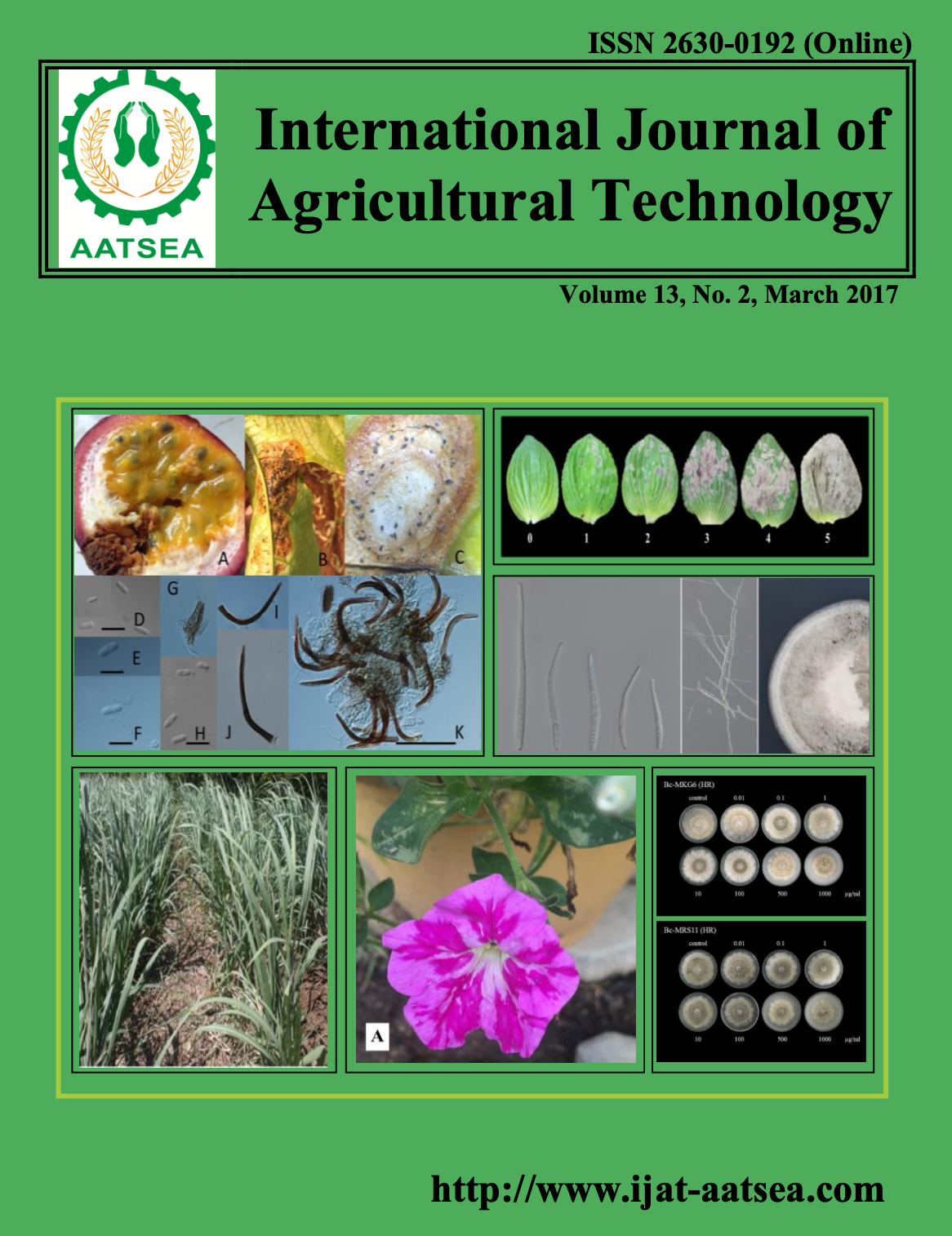Controlling anthracnose of Passion fruit by antagonistic yeast
Main Article Content
Abstract
The purpose of this study was to survey, isolate and collect of the yeast fungi from fruits and vegetable crops. The collected yeasts are used for controlling Colletotrichum boninense a causal agent of passion fruit anthracnose, in the laboratory and in the greenhouse. Seventeen isolates of C. boninense are isolated from various locations of passion fruit farms in Chiang Mai. Of these three isolate are carbendazim resistance. The results shown that 49 isolates of the yeasts are isolated from 28 samples of fruits and vegetable crops. Using dual culture agar plating technique for screening the antagonistic activity against the growth of C. boninense which resistance to carbendazim found that 10 isolate of the yeasts are able to inhibit the growth of this fungus, of these, isolate BMF1 give the maximum inhibiting at 67.69 percent. This BMF1 will be used for the further experiment to control the passion fruit anthracnose in the greenhouse. C. boninense was first described from Crinum asiaticum var. sinicum (Amaryllidaceae) collected in the Bonin Islands, Japan (Moriwaki et al. 2003). According to these authors, the species was associated with a variety of host plants in Japan, including Clivia miniata (Amaryllidaceae), Cucumis melo (Cucurbitaceae), Cattleya sp., Cymbidium sp. and Dendrobium kingianum (Orchidaceae), Passiflora edulis (Passifloraceae) and Prunus mume (Rosaceae).
Article Details

This work is licensed under a Creative Commons Attribution-NonCommercial-NoDerivatives 4.0 International License.
References
Cedeno, L., Mohali, S. and Palacios–Pru, E. (1993). Anthracnose causada por dos cepas de Glomerella cingulate em frutos de parchita. Fitopatologia Venezolana 6:30-33.
Cook, R. J. and Baker, K. F. (1983). The Nature and Practice of Biological Control of Plant Pathogen. American Phytopathological. 539 p.
Crous, P. W, Verkleij, G. J. M., Groenewald, J. Z. and Samson, R. A. (2009). Fungal Biodiversity. CBS Laboratory Manual Series 1. Centraalbureau voorSchimmelcultures, Utrecht, Netherlands.
Janisiewicz, W. J., Tworkoski, T. J. and Sharer, C. (2002). Characterizing the mechanism of biological control of postharvest diseases on fruits with a simple method to study competition for nutrients. Phytopathology 90:1196-1200.
Lubbe, C. M., Denman, S., Cannon, P. F., Groenewald, J. Z., Lamprecht, S. and Crous, P. W, (2004). Characterization of Colletotrichum species associated with diseases of Proteaceae. Mycologia 96:1268-1279.
Martin, F. N., Blair, J. E. and Coffey, M. D. (2014). A combined mitochondrial and nuclear multilocus phylogeny of the genus Colletotrichum. Fungal Genetics and Biology 66:19-32.
Moriwaki, J., Sato, T. and Tsukiboshi, T. (2003). Morphological and molecular characterization of Colletotrichum boninense sp. nov. from Japan. Mycoscience 44:47-53.
Thompson, J. D., Ginson, T. J., Plewniak, F., Jeanmougin, F. and Higg, D. G. (1997). The Clustal_X windows interface: flexible strategies for multiple sequence alignment aided by quality analysis tools. Nucleic Acids Research 25:4876-4882.
White, T. J., Bruns, T., Lees, S. and Taylor, J. (1990). Amplification and direct sequencing of fungal ribosomal RNA genes for phylogenetics. In: Innis MA, Gelfand DH, Sninsky JJ, White TJ, editors. PCR protocob: a guide to methods and applications. San Diego (CA): Academic Press. pp.315-322.


